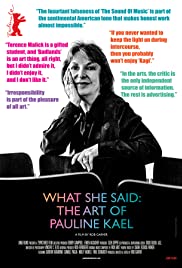
WHAT SHE SAID: THE ART OF PAULINE KAEL
US, 2018, 95 minutes, Colour.
Directed by Rob Garver.
For audiences who have read Pauline Kael’s books and her film reviews, noted over the decades with her very strong opinions, forthrightly given, this is an opportunity to get to know something of the person herself, her background, her journey into film reviewing and comment, devotees and those who are hostile. For those who do not know her, the film opens up the period of film reviewing in the United States from the 1960s to the end of the century.
Pauline Kael was a very strong character. She came from a farming community in California (the film showing scenes of Hud to illustrate this). She watched films from a very young age and decided that this was to be her area – although she did try to write some plays which were not so successful. She had a daughter by an artist, James Broughton, and marriage, briefly to a New Yorker executive. However, she tended to be her own woman – although her daughter was devoted to her, spending a lot of time typing her material because Pauline Kael always wrote in long hand.
She wrote an essay very critical of Charlie Chaplin’s Limelight and that led to further writing, a variety of magazines, losing her job at times because editorial judgements that she was not responding to the current tastes. Eventually, she went to the New Yorker, doing six-month stint with the other six months of the year left to British writer, Penelope Gilliat. At one stage, she went to California to work on a film with Warren Beatty, pulled out, stayed as a consultant. She was also very popular on the lecture circuit.
She was very strong on the role of women in society, commenting how males assume that women could not think as intellectually as they did. She was very strong on the intellectual approach to films, enjoying them, but also analysing how they were made, what they were saying, and the context in which they were made and released. While she was very critical of Andrew’s Sarris and his Auteur Theory, she did take up some favourite directors, taking some credit for their success, especially during the 1970s, including Scorsese, DePalma?, Coppola, but could be very critical about others, taking apart the metaphysics and transcendence of Stanley Kubrick’s 2001.
The film has a great number of talking heads, fellow critics, especially some devoted to her, nicknamed the Paulettes, although one says he was a Paulinista. There are commentaries from the business perspective as well as distribution. There are comments from a number of actors but there are even more comments from directors, especially analysis from Paul Schrader who knew her before he became a film director. Once again, some in favour, some hurt by her criticisms, especially interview sections with David Lean and his reaction to her carving him up at a public meeting.
In some ways, the film is outdated, because Pauline Kael was published in magazines, published critic. The 21st century has seen a proliferation of reviewers as well as anyone having an opinion and having free scope with blogging on particular sites. However, she raises many issues about how a person sees a film, enjoys it, appreciated, criticises it, analyses issues.